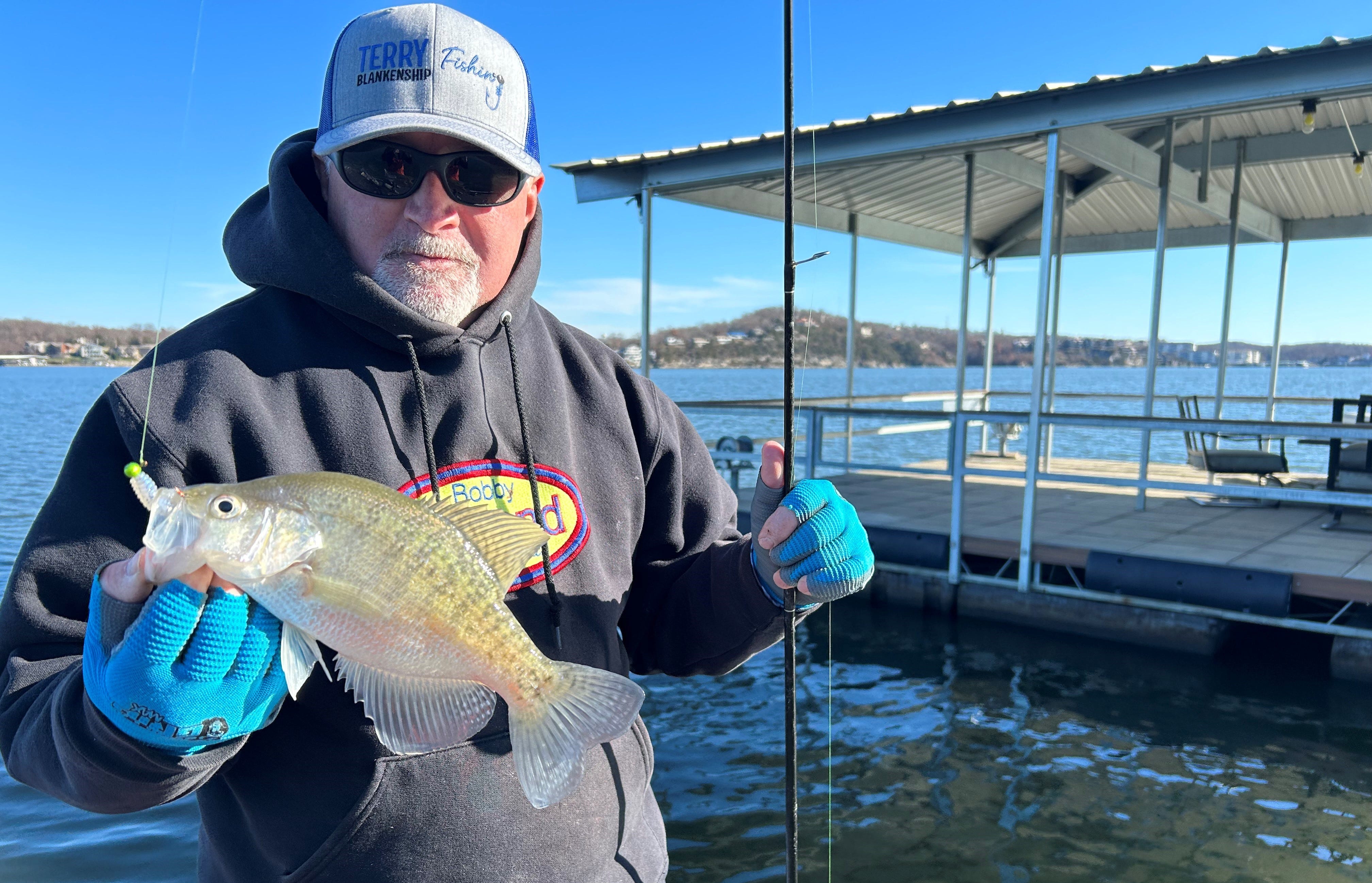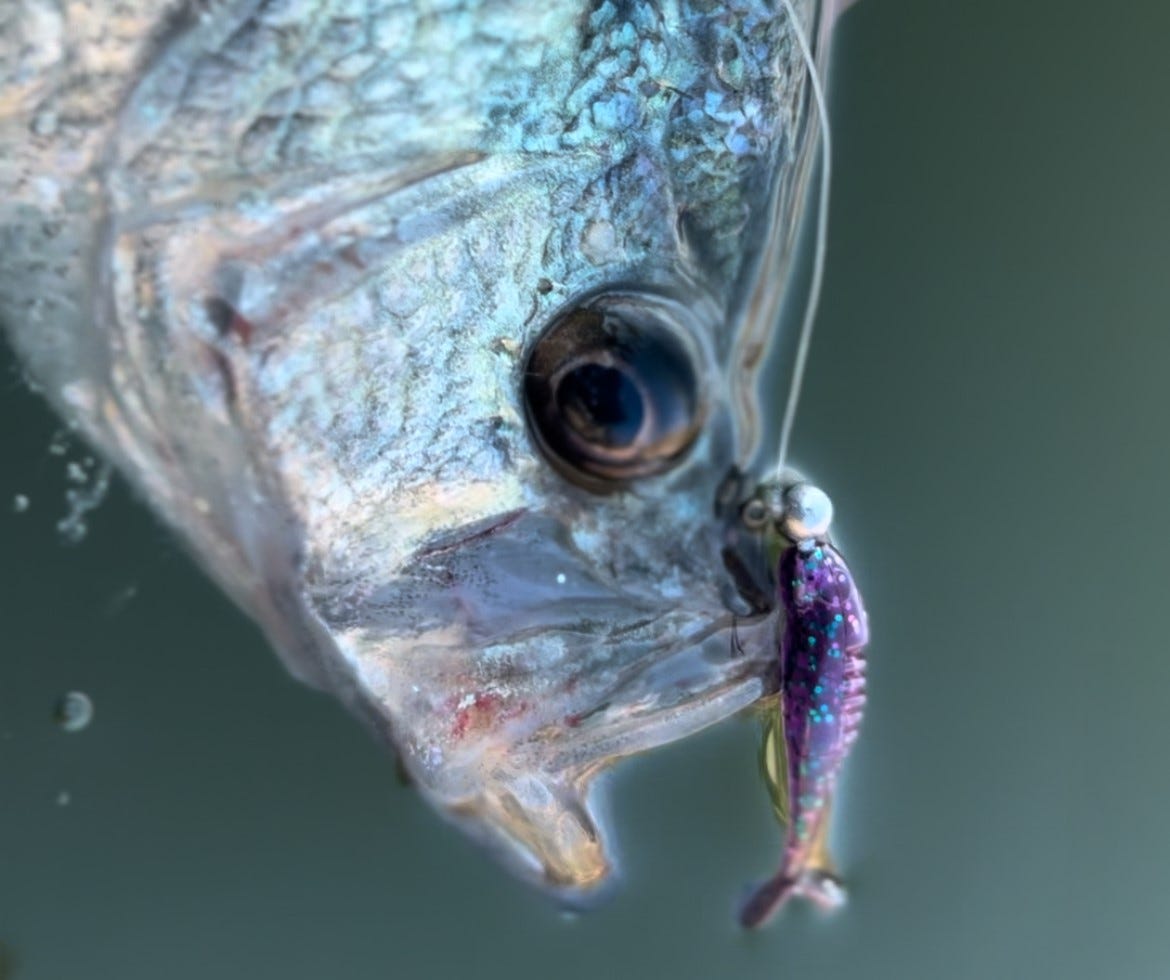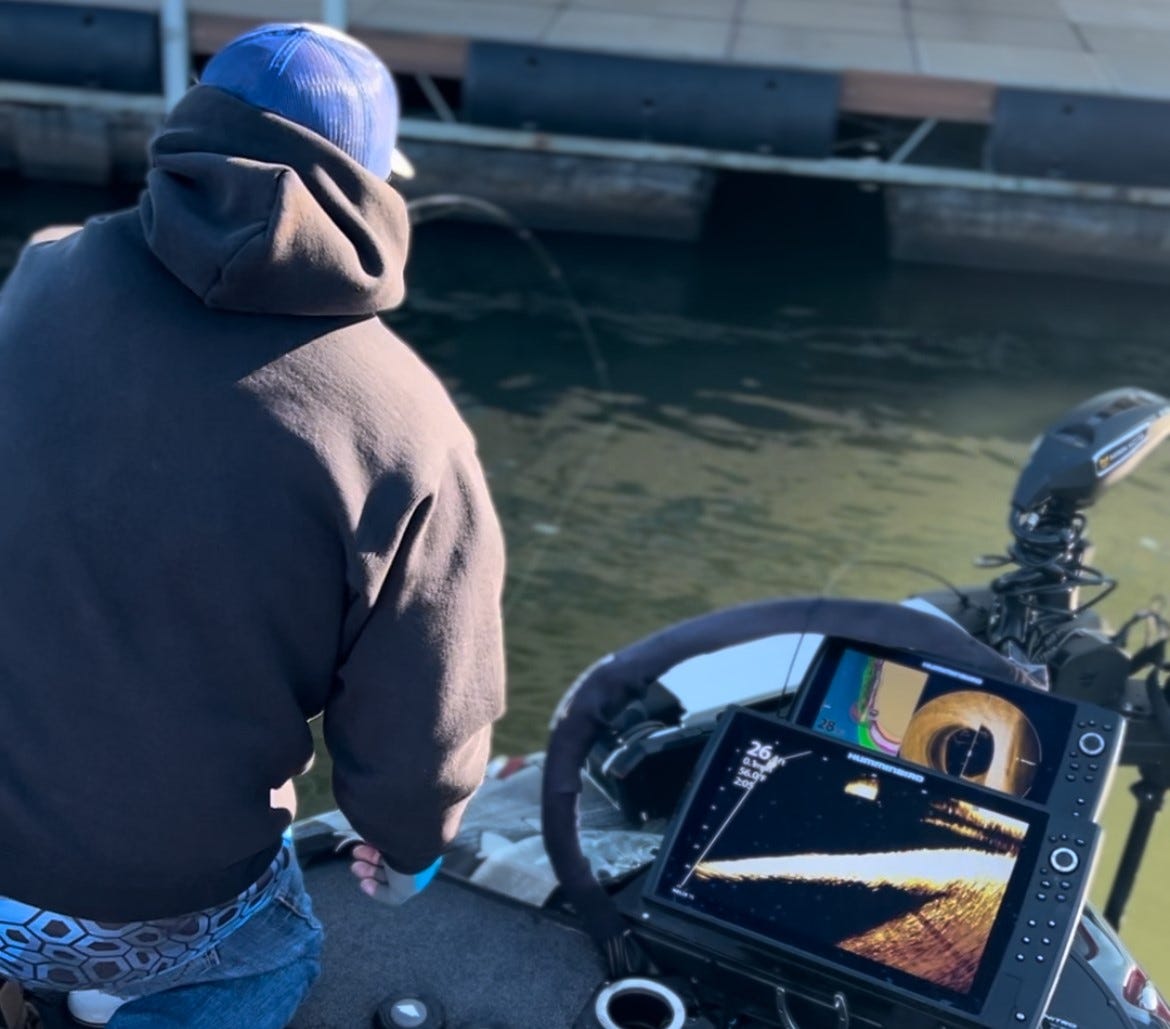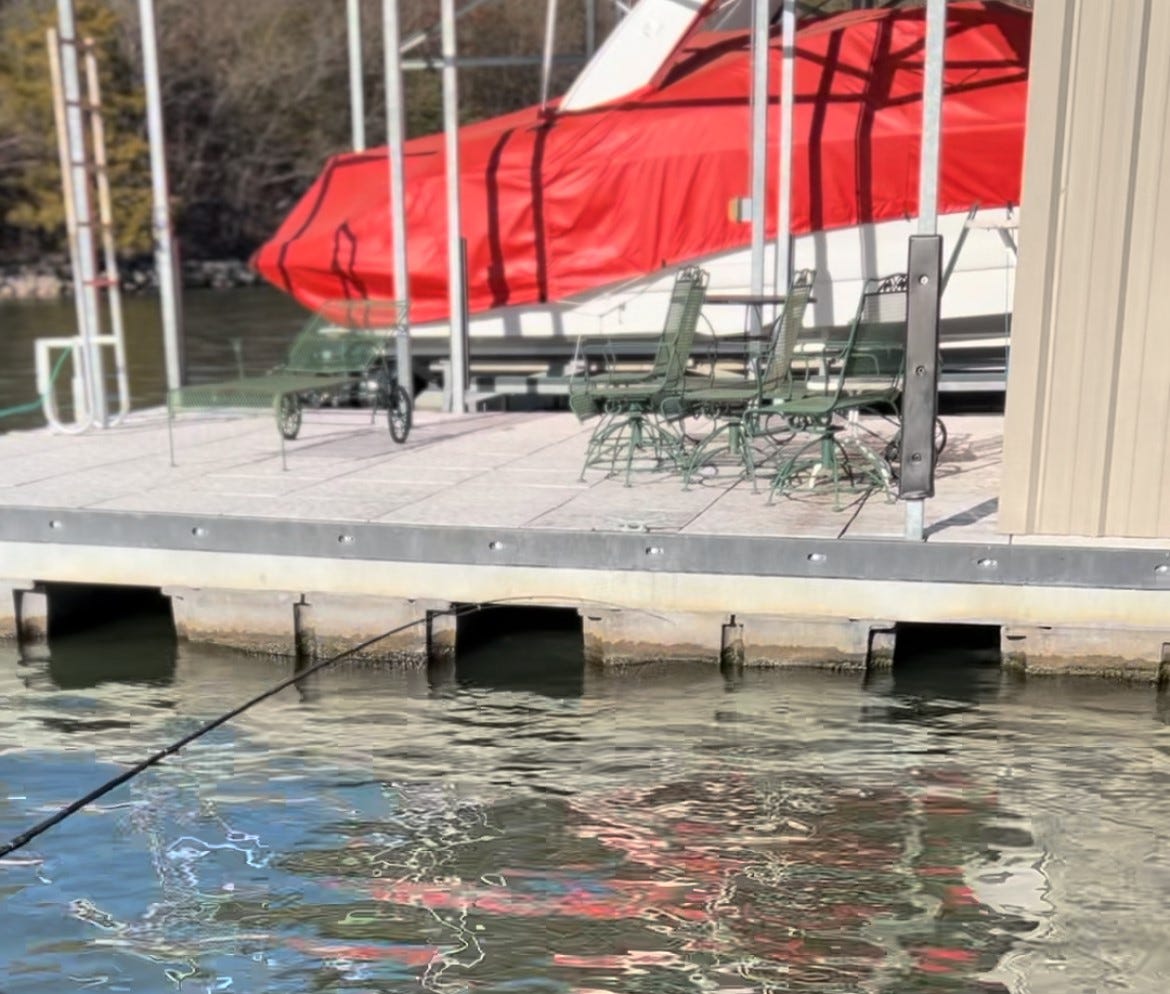- Nov 29, 2023
DOCK SHOOTING: HOW TO FISH DOCKS FOR LATE FALL & WINTER CRAPPIE
Expert tips for crappie anglers of all skill levels. If you like crappie fishing, you need to try dock shooting.


When water and air temperatures force pleasure boaters, water sports participants and beach goers off the water, lake docks become available for “easy” dock shooting.
Make no mistake: Dock shooting isn’t easy. But now is the best time of year to practice, perfect or try it for the first time.
Terry Blankenship is one of the best dock shooting crappie anglers alive today and on a recent fishing outing on his home lake, Lake of the Ozarks, he showcased his skill and shared his tips to help us all catch more crappie dock shooting.
Rod, Line & Jig Options


Odds are the fishing gear you already own is suited for dock shooting, but like any precision skill, there are tools that make the job easier, safer and more efficient.
These tips will help you avoid some early-stage user trial and error at a time of year when most crappie anglers are fishing open water around the main lake channel.
“Your rod type will affect shot trajectory, and your line’s make/test will affect fall rate and bite detection,” Blankenship explained. “Your fishing rod’s flexibility is key.”
If you’ve ever shot a bow or seen a bow shot, dock shooting equipment can be compared simply as such: the fishing rod is the bow, the line is the arrow, and the jig is the broadhead/field point. When paired correctly, the results are lethal for the pursuit.
Medium-Light action spinning rods are best for consistency, aim and distance. Light action spinning rods offer maximum torque for flight and skip speed but will hinder consistency and hook sets. Medium action spinning rods typically lack the flexibility needed for consistency.
Fishing rod length should fall between 5 and 8 feet. The shorter the fishing rod, the higher the launch trajectory. There’s no one size fits all. Just like in golf, each angler will have a unique swing.
“Hi-vis light line with little to no memory is going to put a lot more fish in boat,” Blankenship emphasized.
4-pound to 8-pound fluorocarbon or copolymer line are ideal. Monofilament line holds too much memory, which will significantly decrease bite sensitivity, compounded exponentially with variables like wind, waves, current and visibility.
“Sixteenth-ounce jigheads are perfect for where I fish, but you can shoot ‘em up to 1/8 and all the way down to 1/32,” Blankenship said. “Flat jigs like the Live Roam’R and Crappie Shooter skip best, but you can shoot any body style of jig. The Minnow Mind’R does a lot of damage for me at this time of year.”
Jigheads with snug bait keeper collars will help extend a jig’s life expectancy. You can add a dab of super glue to the bait keeper collar before affixing the jig to get added durability. Dock shooting puts a quick toll on poorly shot jigs. Snug bait keepers and glue will help ensure the jig is fish ready on all those well-placed shots.
Bobby Garland Crappie Baits offers three jigheads designed to hold up against the strains of dock shooting.
Forage transition from fry to fingerlings during this time of year allows for a wide range of jig size and body styles.
Bobby Garland’s Itty Bit Series excels during cold fronts and full moons when crappie are finnicky, well-fed or both. “That Itty Bit Slab Hunt’R in the new color Hummingbird has been my go-to,” Blankenship said. “I’ve also been tearing ‘em up big ones with the Live Roam’R in Pecan Cream.”
Shooting Technique


Like any form of fishing, dock shooting has its hazards. Getting hooked or losing balance are real risks but can easily be averted.
“Always best to wear a life jacket, and never shoot with the hook. Do that and you’ll be alright,” Blankenship offered. “I’ve been doing this a long time. I guide many days a year with folks who’ve never done it before and have yet to have an incident.”
Unlike a peep sight and yardage pins on a bow, dock shooting is more art than science. There’s no perfect method, Blankenship will attest. However, he noted three things to remain aware of when dock shooting.
- Anchor the rod – Anchor the butt end of the fishing rod down your forearm to the elbow. This keeps the rod from jumping, creating a consistent rod tip release.
- Shoot from the head – Hold the jighead by the head, literally. If you’re not going to use https://www.lurenet.com/dock-shoot-r-pull-tabs, never attempt to pull the jig back by the hook shank or bend. Place the jighead between your thumb and first or second finger with the hook point facing away from your hand. When you release your thumb and finger on the shot the hook will not have time or space to turn back toward your skin.
- Keep line above the first eye – No matter the length of your fishing rod, you should only have enough line out to get to the first eye-guide. This is typically the largest eye-guide and first one on the rod above the reel. This will greatly increase aim, accuracy and consistent trajectory.
Dock shooting for crappie is one of the hardest casts in fishing. It often requires placing a jig through an opening no larger than a shoe box at a fast enough speed to reach distances of 10 feet or more. The jig will naturally pendulum back toward you during the fall meaning you need to shoot the bait several feet past the school to retrieve through them.
Point the rod tip directly toward your target. Open the bail and secure the line with the tip of your finger as would for any other type of cast. With your free hand, pull the jig back as far as you can keep the line level with where your rod tip was originally pointed. Release the jig allowing the rod tip to snap back to where it was originally pointed. Leave the bail open until your jig reaches desired depth (typically one foot of fall per second with a 1/16-ounce jighead). Close the bail and initiate your retrieve. Repeat.
Choosing the Right Dock


The advent of side scan and forward-facing sonar has certainly increased anglers’ ability to locate fish quickly and target them effectively, but you don’t need electronics to become a successful dock shooter.
“Dock hopping in a creek arm is a great way to learn a lake and fine tune all your boating skills,” Blankenship said.
Moving from dock to dock in tributary arms offers so many benefits to crappie anglers. For anglers without the latest electronics, it’s an opportunity to practice trolling motor maneuvering, improve shot selection and learn dock features. Those with the latest technology can dial in their graph reading skills, settings and positioning. These lessons help each angler maximize effectiveness on the water.
Regardless of your watercraft or electronics, there are some facts that apply to all dock shooters, with an important one being that not all docks are created equal.
“If they’re concrete, move on, no gaps for shooting,” Blankenship decreed as he sped past what had appeared to be a fishy looking spot from a distance.
Fixed and floating docks offer varying degrees of accessibility. Fixed dock interior and subsurface features are easily identified by sight. There are typically pylons and cross bracing offering the largest target area to shoot through.
Floating docks are the most common on many lakes and come in a variety of designs. Buoyant pads are anchored together to form the platform shape. There are typically two types of shooting windows: boat slips and pad gaps. Depending on the type of boat in the slip, there are two or three shooting lanes. One on either side of the boat and under the boat if it is a pontoon.
Pad gaps are the great mystery on any dock you’ve never fished before. Some are true through gaps going from one side of the dock to the other. Many, however, are dead ends, short air pockets leading directly to the side wall of another pad. “But you don’t know until you shoot. Free practice,” Blankenship joked.
Crappie push up creek arms in the fall and early winter, using docks as travel stops. If there’s depth variability and available forage, many schools will stay in the sheltered water throughout the winter.
“I usually have the docks to myself because most crappie anglers chase the massive wintering schools in deep open water, but there’s more than plenty to be caught under docks ranging from 20 to 5 feet deep,” Blankenship said.
Not only that, but Blankenship loves the water conditions at this time of year for dock shooting. “It opens up 75 percent of the lake that I don’t or can’t fish during the summer.” The constant wave action from boating traffic is gone and the docks are devoid of people. “It’s game on, come the end of November!”



